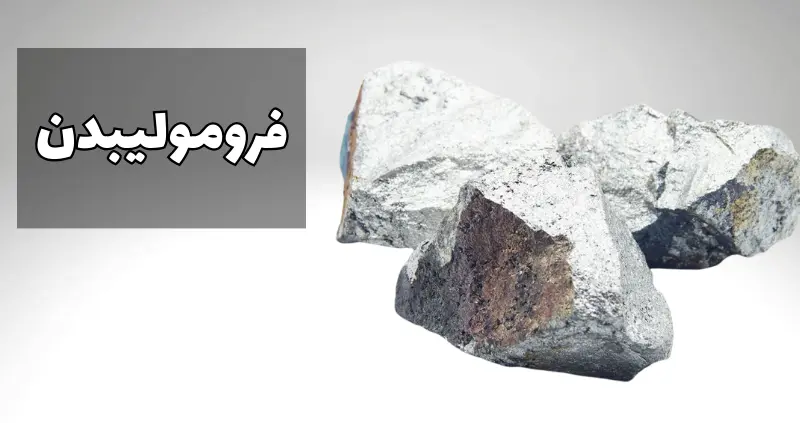
In the world of industry and production, ferroalloys play a vital role. One of these key ferroalloys that is used in many industries including steel production, chemicals, and electronics is ferromolybdenum. In this article, we will examine different aspects of ferromolybdenum, including its uses, benefits, and challenges in its production. Ferromolybdenum, which is known as a ferroalloy, is composed of molybdenum and iron. Molybdenum is a rare element with special properties such as high melting temperature, strength and corrosion resistance that make it an ideal choice for use in ferroalloys.
Applications of ferromolybdenum
Fermolybdenum is used in various industries due to its unique properties. Among these applications, we can mention strengthening and increasing the strength of steels, improving mechanical properties and resistance to corrosion and heat in different alloys. It is also used in the electronics industry and to produce some types of catalysts.
The benefits of using ferromolybdenum
One of the biggest benefits of using fermolybdenum in the production of alloys is improving the physical and chemical properties of steel. This ferroalloy increases the strength, hardness, and resistance of steel against high temperatures and corrosion. In addition, it helps to produce steels with favorable mechanical properties and high performance in harsh conditions.
Challenges of production and use
One of the main challenges in the production of this product is the supply of high quality molybdenum. Molybdenum extraction and purification are complex and costly processes that affect the final price of this product. Also, the production of this product requires special technologies and technical knowledge that can limit the access to this ferroalloy.
the future of ferromolybdenum
Given the continuous growth of consumer industries, demand for ferromolybdenum is expected to increase in the future. Advancements in technology and improvements in production processes can help reduce costs and increase access to this product. In addition, further research on new uses and optimizing the properties of this product can lead to novel and valuable applications.
Sustainable development and ferromolybdenum
One of the key aspects that will be emphasized in the future production and use of ferromolybdenum is sustainable development. This includes optimizing extraction and production processes of molybdenum, reducing environmental impacts, and using eco-friendly methods in the production of alloys. With an increase in awareness and demand for sustainable approaches in industry, the pressure to adopt production methods that cause minimal damage to the environment will rise.
Innovation in the applications of ferromolybdenum
assistant: Moreover, exploration and innovation in new applications of this product can open up new markets for this alloy. Among others, we can mention the development of new alloys for the aerospace and defense industries, which require materials with high melting temperatures and extraordinary strength. In addition, the use of fermolybdenum in the production of new equipment and materials for renewable energy industries and also as a catalyst in environmental chemical processes can be other aspects of future development.
Limitations and opportunities
While there are limitations such as high production costs and the need for advanced technology, the opportunities for innovation and improvement in the industry of this product are significant. Optimizing production and extraction processes, research and development in the field of new applications and focusing on sustainable production can help to overcome these challenges and make optimal use of opportunities.
International cooperation and technical knowledge development
One of the key ways to advance the ferro-molybdenum industry is to strengthen international cooperation and the exchange of technical knowledge between countries and companies active in this field. Creating research and industrial networks can help speed up the innovation process and improve production quality. Also, access to molybdenum resources and advanced production technologies, through international cooperation, can reduce costs and improve production efficiency.
Increase public awareness and acceptance
Increasing public awareness about the importance and applications of fermolybdenum can also help expand its markets. Public education about the benefits of using ferroalloys in various industries, including reducing environmental impacts and increasing production efficiency, can lead to greater adoption of these products. In this way, the demand for this product in the global market has increased and new opportunities for growth and development are provided.
Sustainability and environment
Focusing on sustainability and environmental protection should be at the center of the development of ferromolybdenum related technologies. The development of production methods with less damage to the environment, reduction of greenhouse gas emissions, and the use of sustainable sources for molybdenum extraction are among the important measures in this direction. Adopting green approaches in all stages of production and use of this product can help strengthen its acceptance by consumers and local communities.
Conclusion
Fermolybdenum, as a key ferroalloy in various industries, plays an important role in improving the properties and performance of materials. Despite the challenges related to production and use, technological advances and continuous research can lead to increased efficiency and reduced costs associated with this ferroalloy. The future of this product in the industry depends on continuous innovations and improvements in all stages of its production and use.
